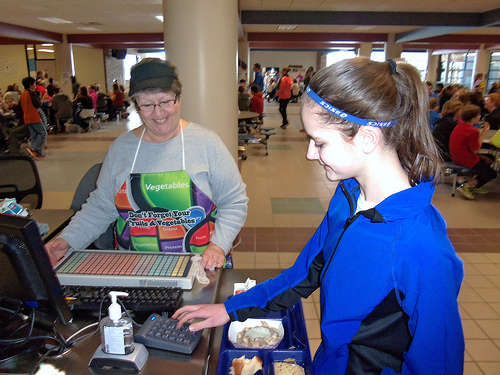by Dennis Dalman
news@thenewsleaders.com
Every school day, lunch workers in the Sartell-St. Stephen School District serve 2,500 hot lunches, and about 500 of those meals are free or reduced-price lunches for students from low-income families.
Every now and then, some of those low-income students do not get a hot lunch. Instead, they are given a choice of a peanut-butter sandwich or cheese sandwich, along with a carton of milk. Each student has a lunchroom pin number. After they fill their hot-lunch trays, they enter their pin numbers at the end of the line where the cashier sits. The cashier can then see instantly on the computer screen the status of any student’s hot-lunch account. If the account is delinquent, the cashier will set the student’s food-filled tray aside, and the student is given a certificate-coupon, which is good for the sandwich lunch. Using the certificate, the student also has the option of going to the office to call parents to remind them the account is empty. If a student makes that call, he or she can return to the cafeteria, give the certificate-coupon back to the cashier and receive the hot lunch.
Before the sandwich option goes into effect, however, each family is allowed to have up to three hot lunches charged, until they put more money in their students’ lunch accounts. In kindergarten through fourth-grade, students’ families can have an unlimited amount of charges. In the meantime, the schools notify the families up to twice a week via phone calls or emails that the lunch accounts must be paid, otherwise the students cannot have hot lunches.
“We don’t have a lot of issues with it,” said Brenda Braulick, food-services director for Sartell schools. “It (the policy) has worked well here, and this policy has been in place even before I started here 14 years ago.”
Braulick said so far this year there has been “just a handful of times” when students were given sandwiches instead of hot lunches when their accounts had overdue balances. Mostly, it’s a matter of forgetfulness on the part of parents, she said.
“There are so many busy families that some just forget,” Braulick noted. “By and large, parents are very responsible.”
Braulick said the staff tries to be very discreet when giving a student the sandwich option.
“We don’t want to shame or stigmatize any student,” she said.
Notifications
Parents are notified by the schools when there is only $20 remaining in lunch accounts. Then, they are notified again if that amount gets down to $10. They are also told if money cannot be placed in the accounts, the parents should consider sending bagged lunches with their children.
The full cost of a hot lunch is $412.80 per student for the 172-day school year. A lunch costs $2.30 in elementary schools and $2.40 for students in grades 5-12. There is also a “Sabre” meal option at $3.05 where entrees are more expensive and upscale, but students on free or reduced-lunch prices, Braulick noted, are allowed to get Sabre meals if they choose.
The cost to parents of a reduced-price lunch is 40 cents per meal per student, which means parents are expected to pay about $70 per year for children in grades K-12. A combination of state and federal reimbursements covers the rest of the cost of each meal, Braulick noted.
Federal income guidelines determine which families can get free or reduced-cost lunches, based on family income levels.
Survey
A widely publicized incident in a Salt Lake City, Utah grade school caused many school districts to revisit their lunchroom policies regarding children whose parents do not pay up lunch accounts.
In the Utah school, on Jan. 31, some students were given bagged lunches after their food-filled hot-lunch trays were taken from them in the lunch line and tossed in the garbage in front of them and their fellow students. Rules forbid food on a lunch tray to be re-used for other students.
The Utah incident caught the attention of Minnesota Gov. Mark Dayton, who has proposed spending state money so all students in low-income families receive free hot lunches.
The news from Utah also outraged many parents and educators and spurred a statewide survey taken by Mid-Minnesota Legal Aid. Ninety-four percent of the state’s school districts participated in the survey, which asked questions about school-lunch policies regarding students whose lunch accounts are empty.
Forty-six percent of the districts, including Sauk Rapids-Rice, have policies to refuse immediately or eventually hot lunches to children with delinquent accounts. About half of those districts offer, instead, lunches that are less ample and less nutritious. Some district stamp “LUNCH” or “MONEY” on students hands to remind them to tell parents the lunch-accounts need to have money in them.
Slightly more than half of the 309 school districts, 165 of them, offer less-nutritious alternatives to hot lunches. They include St. Cloud and Sartell.
About a third of districts, 98, will always provide a full-menu hot lunch to low-income children even if they cannot afford the cost. One such district is Little Falls. Those districts have developed strategies to cover the costs, which include Parent-Teacher-Association “angel” accounts, discretion by the principal, school-board-approved appropriations and future recovery when parents are able to pay.
Comments
The comments by participants in the survey varied widely in attitudes and philosophies.
Without naming particular districts, the survey listed some of the comments. The following are summaries of those comments as printed in the survey:
“Many districts described the critical importance of a healthy lunch and ensuring the best nutrition for all students, particularly for those students who are economically vulnerable.”
“A few districts reported serving butter sandwiches.”
“One district described other districts’ practices of providing alternative meals and turning away children as ‘unconscionable bullying.’ ”
“A few districts reported pulling trays and dumping exposed food into the trash in front of the child.”
“One district policy states: ‘Lunch trays will be pulled from a student if there is not enough money in the account. We do not enjoy pulling trays from students and it slows the line for other students trying to get through.’ ”
One district justified its tray-pulling policy as a way of teaching children accountability and responsibility.
“Many districts absolve themselves of responsibility for ensuring children do not go hungry, claiming parents are the ultimate decision-makers on whether their child eats.”
“Several districts do not view a refusal to serve food as ‘turning children away.’ Many policies are stark. At a certain level of deficit, the language states: ‘students will not be allowed to eat,’ ‘students will be denied to eat lunch,’ ‘we stop the student from taking lunch’ or ‘student will be asked to replace wrapped food; unwrapped food will be discarded.'”

In the cafeteria, seventh-grader Kami Counter, who pays full lunch prices, enters her pin number at the Sartell Middle School’s cashier’s station. The cashier is Sharon Schnapp. The Sartell-St. Stephen School District serves 2,500 lunches each day.




